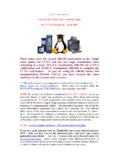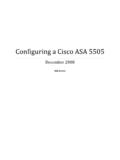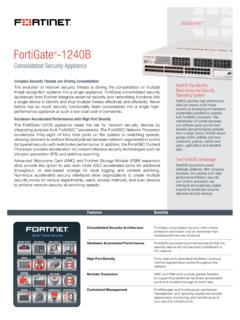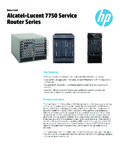Transcription of Secure Use of VLANs: An @stake Security Assessment
1 AUGUST 2002 Secure Use of vlans : An @stake Security Assessment In the interests of identifying and precisely defining Security risks associated with vlans implemented using the Cisco Catalyst family of products, @stake designed and executed a comprehensive test program. Through techniques devised to penetrate Security weaknesses from a staging point within one VLAN, the @stake test suite attempted to send packets to a different VLAN and receive packets from a different VLAN. The results of @stake s test sequences clearly demonstrate that vlans on Cisco Catalyst switches, when configured according to best-practice guidelines, can be effectively deployed as Security mechanisms.
2 @STAKE, INC EMAIL: BOSTON DENVER HAMBURG LONDON NEW YORK RALEIGH SAN FRANCISCO SEATTLE Research Report @stake consultants David Pollino and Mike Schiffman, CISSP, conducted the testing and analysis. Mr. Pollino is the Director of the Wireless Center of Excellence at He is a respected information Security consultant with an extensive networking background. Mr. Schiffman is the Director of Security Architecture at He has researched and developed many cutting-edge technologies, including tools such as firewalk and tracerx, and Libnet. He has also spoken in front of several institutions and government agencies such as NSA, CIA, DOD, AFWIC, SAIC, and army intelligence.
3 Executive Summary vlans offer a flexible, agile means of securely organizing network segments within an enterprise. Despite the promise of VLAN architecture to simplify network maintenance and improve performance, Security questions have raised concerns and caused some network architects to re-examine the associated issues. One area of concern, VLAN hopping, involves a variety of mechanisms by which packets sent from one VLAN can be intercepted or redirected to another VLAN, threatening network Security . Under certain circumstances, attackers have been able to exploit these mechanisms, gaining the capability of sniffing data at the switch level, extracting passwords and other sensitive information at will.
4 As part of the Security Assessment that is summarized in this paper, @stake performed a battery of tests to evaluate the Security features of the Cisco Catalyst family of products. @stake has earned international recognition for expertise in network and application Security solutions, and has configured and deployed vlans for many of the world s largest enterprises. Cisco Systems decision to hire @stake as an independent third-party consulting firm relied strongly on @stake s reputation in this field. The results of @stake s test sequences clearly demonstrate that vlans on Cisco Catalyst switches, when configured according to best-practice guidelines, can be effectively deployed as Security mechanisms.
5 Best-practice guidelines appear in summary in this paper and are detailed extensively in the Cisco document, SAFE: A Security Blueprint for Enterprise Networks. Secure USE OF vlans : AN @STAKE Security Assessment 2002 @STAKE, INC. ALL RIGHTS RESERVED 2 Cisco VLAN Security Review In the interests of identifying and precisely defining Security risks associated with vlans implemented using the Cisco Catalyst family of products, @stake designed and executed a comprehensive test program. The test suite, summarized in this section, targeted both known and theoretical vulnerabilities with the Catalyst family of products.
6 Through techniques devised to penetrate Security weaknesses from a staging point within one VLAN, the @stake test suite attempted to send packets to a different VLAN and receive packets from a different VLAN. Testing Scenarios Test suites were constructed using open source tools, and proprietary software and utilities developed by Four Cisco Catalyst switches used in the VLAN configurations supported several test configurations, including a single-switch VLAN, multiple-switch VLAN, and vlans with and without trunk ports enabled. Tests were conducted with knowledge of existing vulnerabilities, and were focused on identifying any unknown or potential vulnerabilities outside of well-understood issues, such as VLAN hopping through enabled trunk ports.
7 Categories of Tests @stake employed a number of categories of tests during the Security analysis, and executed several different individual tests in each category. Certain categories of tests are highlighted in the section below: Frame Tagging: Through use of different forms of encapsulation (including ISL and ), these tests attempted to forward frames to a different VLAN, bypassing normal Security constraints. Denial of Service or Failure Conditions: In these tests, @stake attempted to send frames to the switch to cause abnormal or Denial of Service (DoS) behavior.
8 These DoS attacks included: CAM Table Attacks. By attempting to overwrite the CAM table entries on a VLAN, these tests attempt to interrupt traffic and force a switch to forward packets to different destinations. Flooding. Flooding attacks rely on one or more attacker machines to produce denial of service situations, such as producing MAC flooding to get a switch to exhibit an abnormal failure condition. The response of a switch to the resulting failure condition represents a potential Security hole. Multicasting techniques generating frames to a wide range of addresses over extended periods in an attempt to produce a failover scenario also fit in this category Address Spoofing: Forging MAC addresses and attempting to redirect traffic and extract data from packets represents a common technique for defeating Secure USE OF vlans : AN @STAKE Security Assessment 2002 @STAKE, INC.
9 ALL RIGHTS RESERVED 3 Security measures. Tests in this category apply address spoofing in an attempt to redirect VLAN traffic with malicious intent. @stake Testing & Results The independent testing performed by @stake, at the request of Cisco Systems Incorporated, evaluated the Security issues associated with vlans in the context of a deployment on the Cisco Catalyst family of products. The test methodology included attempts to circumvent VLAN network Security by launching an aggressive series of attacks to exploit both known and theoretical vulnerabilities in the Cisco Catalyst family of products.
10 Following testing, @stake offered recommendations on updating the Cisco best practices framework for maintaining optimum VLAN Security . At the conclusion of this testing, @stake determined that there is minimal risk when deploying vlans across Security zones. The following table summarizes @stake findings for tests on Cisco 2950, 3550, 4006 and 6000 Series Catalyst Switches. The analysis baseline, lab configuration and version information used to conduct the testing are itemized in Exhibit A: Analysis Baseline. @stake Testing TEST RESULTS MAC Flooding Attacks Normal behavior observed; traffic was repeated on local VLAN only.










